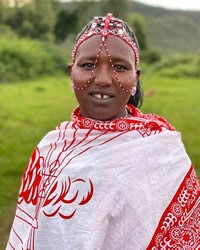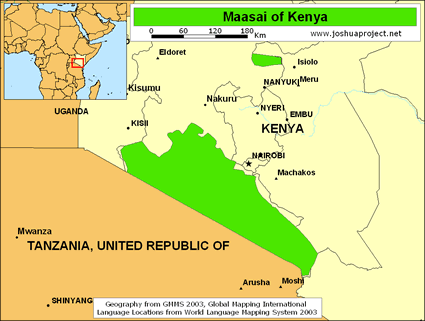The Maasai (or Masai) are semi-nomadic people located primarily in Kenya and northern Tanzania. They are considered to be part of the Nilotic family of African tribal groups, just as the Scilluk from Sudan and the Acholi from Uganda.
The Maasai probably migrated from the Nile valley in Ethiopia and Sudan to Maasailand (central and south-western Kenya and northern Tanzania) sometime around 1600 AD, along the route of lakes Chew Bahir and Turkana (ex Rudolph), bringing their domesticated cattle with them.
Once considered fierce warriors, feared by all tribes in the zone, the Maasai lost most of their power during the late 1800s, as a consequence of a string of natural and historic calamities. They were hit by drought, smallpox, and cattle pest, and contemporarily had to mourn the departure of Laibon Mbatiani, their respected and much-admired leader, direct descendant of the mythical OlMasinta, founder of the tribe.
The Maasai speak the Maasai language, an Eastern Nilotic language closely related to Samburu (or Sampur), the language of the Samburu people of central Kenya, and to Camus spoken south and southeast of Lake Baringo. Over half of the Maasai people live in Kenya, though some live in Tanzania. Though they have their own Massai language, most also speak Swahili, the lingua franca of East Africa.
The Maasai, Samburu, and Camus people are historically related and all refer to their language as Maa, although they acknowledge mutual cultural and economic differences.
The Maasai are cattle and goat herders, their economy almost exclusively based on their animal stock, from which they take most of their food: meat, milk, and even blood, as certain sacred rituals involve the drinking of cow blood. Moreover, the huts of the Maasai are built from dried cattle dung.
In spite of their reputation as fierce warriors, Maasai culture revolves around their cattle. One of their spiritual beliefs is that their rain god Ngai gave all cattle to the Maasai people, and therefore, anyone else who possesses cattle must have stolen them from the Maasai. This has led to some fatal altercations with other tribes of the regions over the centuries when they attempt to reclaim their "property".
Maasai men perform numerous traditions and ceremonies. Perhaps best known is the warrior "jumping" dance, where young Maasai morani (warrior-youth) leap into the air from a standing position, in order to demonstrate their strength and agility.
Until recent times, in order to earn the right to have a wife, a Maasai man was required to have killed a lion. Officially, this practice has stopped, although there is evidence that it continues in the more remote regions of Kenya. Also in earlier times a group of young boys were required to build a new village and live in it for a lengthy period (often years) as part of the passage to manhood. This practice is dying out. Unlike many tribal cultures, Maasai women have a strong voice in their culture. Maasai women are easily identified by their shaved heads, bright clothing and beads, and the removal of one of the bottom teeth (for both sexes).
Circumcision is performed on both sexes, with the elder men circumcising the teenage boys (who are not permitted to make a noise during the ceremony), and the elder women circumcising the teenage girls (for whom crying is permitted). Attempts by the Kenyan government to stamp out female circumcision have failed, primarily due to the fact that it is the Maasai women who defend the practice, not the men.
Ethnic religion is prominent in Massai culture, but a large percentage are Christian. They can be Protestant or Catholic.
Despite the growth of modern civilization, the Maasai have largely managed to maintain their traditional ways, although this becomes more challenging each year. The ability to graze their cattle over large territories, for example, has diminished considerably in recent years, due to increased urbanization and the declaration of the Maasai Mara and Serengeti game reserves, which was all formerly Maasai grazing land.
Pray for the Holy Spirit to move powerfully in Maasai churches and families.
Pray for them to draw close to the only Savior, Jesus Christ, and desire an even closer walk with him.
Pray for hundreds to be called and sent by their churches to the spiritually lost in Africa.
Scripture Prayers for the Maasai in Kenya.
Anonymous.
| Profile Source: Joshua Project |












